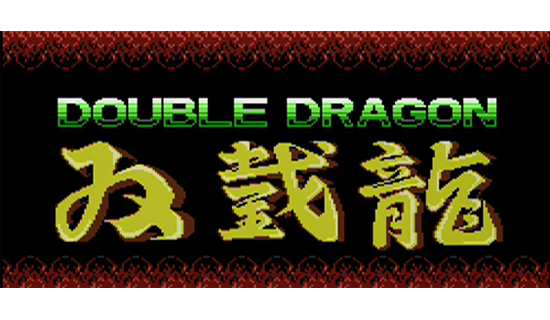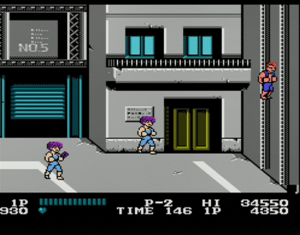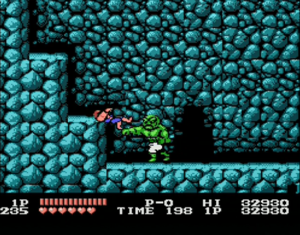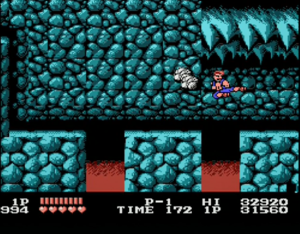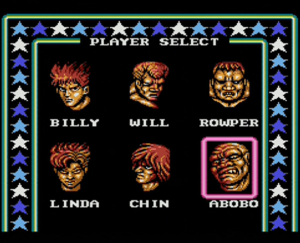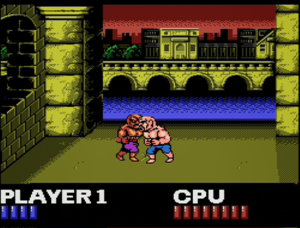Almost a year after the original arcade hit, Double Dragon was brought home to the Famicom. This is the first of the handful of home ports that Japan would see of this game, and the NES version is probably among the first to be seen throughout the rest of the world (the microcomputer versions don’t have exact dates associated with them, other than just 1988). The Famicom port probably didn’t deliver the experience that big fans of the arcade version wanted, but it succeeded on its own merits.
Hardware limitations of the Famicom resulted in some understandable differences from the original. As you might expect, this first home version is graphically inferior. In fact most of the sprites look so dissimilar to their arcade counterparts that someone who put a lot of money into a Double Dragon machine may not even recognize many of the individual characters. And while the arcade cabinet was upgraded from Kunio kun’s meager two buttons up to three (jump now has its own button), this was obviously not possible on the Famicom/NES controller. So the jump kick was once again made possible by pressing both buttons at the same time. Logically you’d also think that the music took the same hit that the graphics did, and technically speaking it probably did. But the arcade soundtrack seems a little stunted and slow paced by comparison. My opinion may be colored by playing the NES version so much more than the arcade version as a kid, but there’s something to be appreciated about just how hard Technos Japan tried to make that Famicom sound chip wail out those synthesized guitars. No attempt was made to preserve the voice samples found in the original though, which is fairly typical for a Famicom game at this time.
There are many more differences that, as rumor has it, are a result of programmer inexperience with the Famicom hardware. Only two enemies ever appear on the screen at the same time, and they’re always the same enemy. This is one difference that I really appreciate though, since I found myself getting overwhelmed by enemy numbers sometimes when playing the original. Whether or not it’s a result of programming inexperience, the enemy AI is also much less harsh in the Famicom version, and enemies take considerably less hits to kill. This is probably also responsible for the lack of slowdown that was present in the arcade version whenever more than a few enemies were on screen at once. So in terms of combat, you’ll probably have a much easier time. Level layouts were drastically changed in some cases, and a couple of enemies were removed completely from the game. Chin Taimei was an original character that was added specifically for this version, though he would be used again in later entries in the Double Dragon series. Weapons also always disappearing after clearing a group of enemies, even if you’re holding the weapon. A strange black square also persists in the lower right corner of the screen throughout the game, which research has indicated is an actual sprite. It’s not particularly annoying (I don’t think I even noticed it as a kid), but no one seems to know why it’s there.
Some other changes were very intentional decisions. Instead of having access to all moves from the start, you earn most of them through a barely visible leveling system. The more enemies you kill, the quicker that heart meter at the bottom increases to give you access to the hair grab/punch/throw combination (this version’s equivalent of the elbow smash). While it isn’t a particularly annoying addition, its inclusion is just baffling. I couldn’t find an answer as to why it was implemented, but it’s likely either an attempted balance for the decreased difficulty level or just another case of putting RPG elements in a game where they don’t belong (this was released in a post Dragon Quest world, after all). A minimal checkpoint system has been implemented, but there also is no way to continue once your few lives are gone. This really turns into a problem in the most redesigned level of the bunch: level 3. Instead of progressing straight through the forest to the enemy base entrance, you’re instead taken into a cave. Not only do you need to deal with falling stalactites, but also the worst possible thing that could be put into a game with a short and ineffective jump: Platforming. This is arguably the Famicom port’s biggest sin, and marks the difficulty spike that makes most players give up due to the lack of continues.
The other contender for biggest sin is the removal of two player simultaneous play in favor of alternating play. To blatantly remove one of the most notable features of the arcade game was a ridiculous decision, and almost certainly was due to the previously mentioned programmer inexperience and/or tight deadlines. Remarkably though, the story was actually adjusted to account for this. Billy Lee becomes the sole main character, and after beating the “last” boss it’s revealed that his brother Jimmy is actually the mastermind, and the bothers fight (a play on the two players being made to fight each other after beating the final boss in the arcade version, no doubt). What Technos Japan gave us instead of a real two player mode was the prototypical fighting game known as “Mode B” on the opening menu. Here you choose from larger versions of all characters (who are also all redrawn for the character select screen) but the two Lee brothers, and you and your opponent (whether it be the computer or a second player) will face off against one another as that same character. This is really just a fighting game that uses the existing Double Dragon engine, which was absolutely not made for such a thing. Even as a kid I only ever played this mode with friends a couple of times before realizing it wasn’t worthwhile. Mode B isn’t anything more than a curiosity, but it does raise the question why was it even made in the first place, and where did the inspiration come from? Fighting games as we know them didn’t really exist yet, outside of the original Street Fighter that had debuted in arcades August of the previous year. It wasn’t particularly popular though. Was this hastily thrown together or incomplete content that was meant to be a bonus for this version of the game? Or, god help us, is this what they originally intended the Famicom port to be before realizing it was either a terrible idea or not feasible? I’ve heard claims that this was in fact the original prototype, but haven’t been able to find any real confirmation.
In comparing the Famicom/NES port to its arcade original, nostalgia often declares the Famicom/NES port winner since a lot of kids played Double Dragon at home exclusively, or before the arcade game. Something just feels more satisfying about the lower level of difficulty (minus the second half of level 3 that is) and fewer number of enemies too. If I’m playing alone, I’ll usually pick this version over the original. This port specifically can be found on the Wii, Wii U and 3DS virtual consoles across all regions. This is great news, because anything approaching a complete version of the original cartridge is not cheap, particularly when it comes to the Famicom version.
